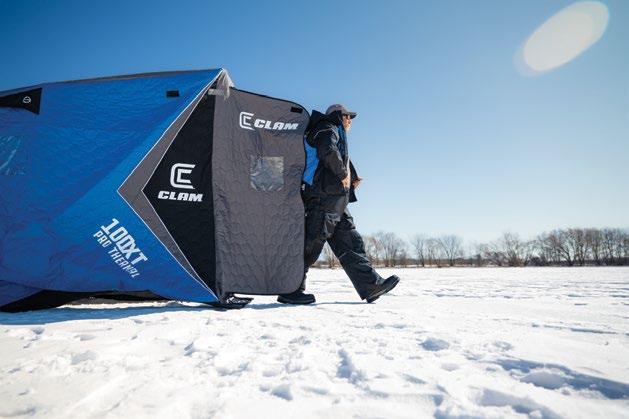SPOON FEEDING
FISH
HANDLING ICE FISHING PRESSURE
SPEED SPOON
PLASTICS FOR THE HARD WATER
SIGHT FISHING IN THE WEEDS
KEYS FOR LAKE CASCADE
SUCCESS
THE FROZEN KITCHEN
CHASING DOWN WALLEYE
CATCHING THE MIDDAY BITE
MID-WINTER CRISIS SHACK MODS
TERMINAL TACKLE FOR ICE FISHING
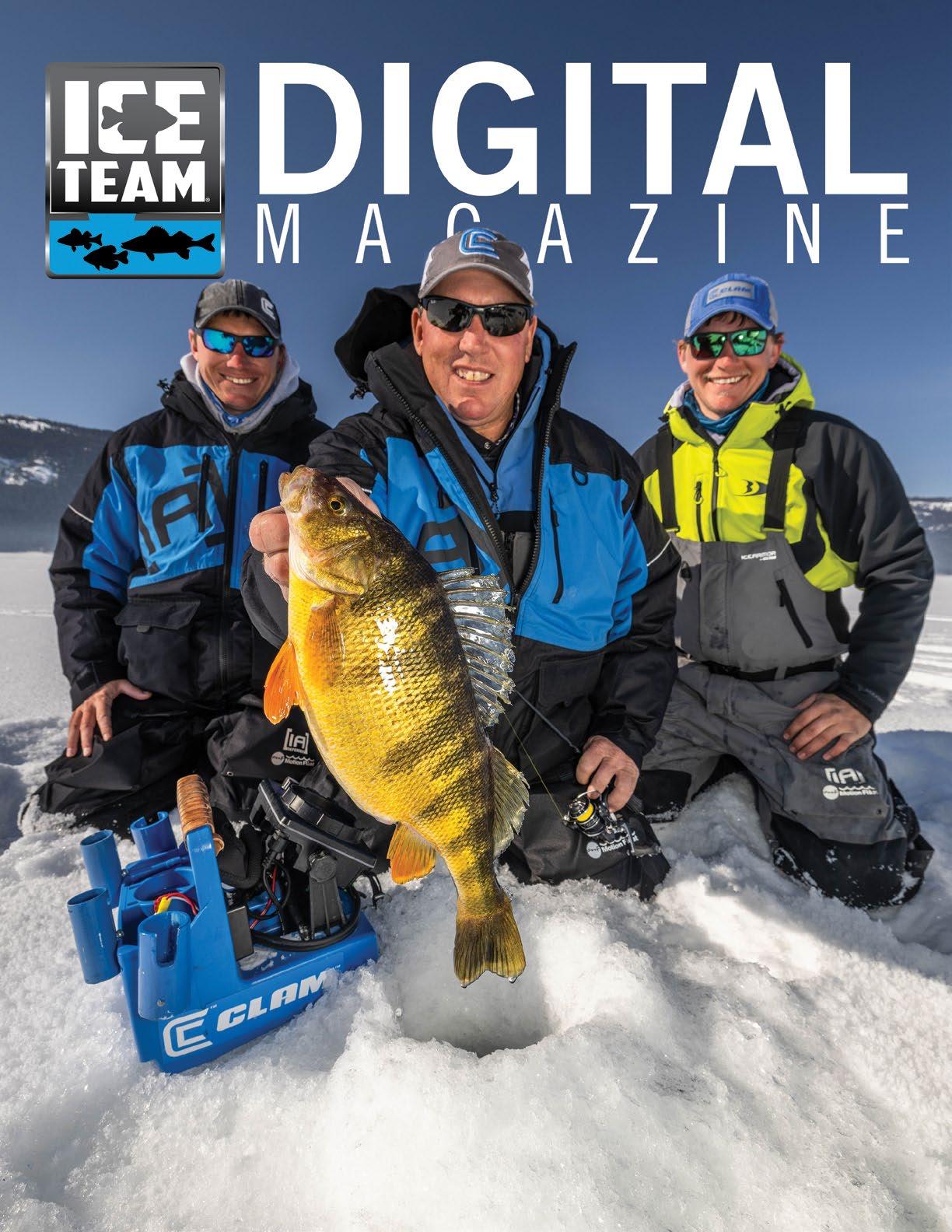
FEBRUARY ISSUE | 22-2023



Full line of products at mrheater.com • 800.251.0001

Whatever the catch, we’ve got it covered. Whether it’s fresh from the lake or straight from the store, your favorite meals are even better with Shore Lunch. Try our breading, batters, soup mixes and more today for a taste of the shore, no matter where you go. shorelunch.com



DIGITAL Magazine TABLE OF CONTENTS 10 HANDLING ICE FISHING PRESSURE 06 SPOON FEEDING FISH Ice Team Magazine Editors: Matt Johnson = Contributing Writers: Jason Mitchell, Jerry Carlson Ryan Pinkalla, Steve Weisman Cory Yarmuth, TJ Barron, Don Cox, Vic Attardo, Jeff Elliot Ross Robertson, Scott Seibert Kyle Lynn, Mike Hungle The True Center of the Ice Fishing World PH: 763 - 231 - 4126 FAX: 763 - 231 - 4121 Email: info@iceteam.com Website: iceteam.com Ice Team Manager Matt Johnson facebook.com/ IceTeamRevolution twitter.com/IceTeamNews youtube.com/IceTeamVideos Advertise with Ice Team Call MSPN at 800 - 989 - 6776 or email sales@iceteamfishing.com Blue42 Agency 17 2nd Street NW Osseo, MN 55369 PH: 612 - 584 - 1395 Email: support@goblue42.com Website: goblue42.com Editorial Director: Matt Johnson Art Director: Brian Lindberg Design: Jeff Bibbs 12 SPEED SPOON 16 PLASTICS FOR THE HARD WATER 20 SIGHT FISHING IN THE WEEDS 36 CATCHING THE MIDDAY BITE 22 KEYS FOR LAKE CASCADE SUCCESS 38 MID-WINTER CRISIS 26 THE FROZEN KITCHEN 42 SHACK MODS 30 CHASING DOWN WALLEYE 44 TERMINAL TACKLE FOR ICE FISHING

6 >> iceteam.com >> Ice Digital February 2023 Issue
Spoons. If you were to look through any old angler’s tackle box, be it an open water collection or a hard water collection you will more than likely find a spoon or twenty. Spoons have been around forever. They were first devolved around 1848 and although sizes, colors, actions, profiles, and flair have come a long way over the last one hundred and seventy years or so, the basic concept of the spoon has never really truly changed. A spoon is an oblong, concave chunk of metal or plastic with an appetizing paint job and a single or treble hook at the end. Some manufacturers will spice it up with feathers or beads for added attraction.
Spoons play a huge part in the ice fishing world not just for Northern Pike or Walleyes but for Panfish as well. More and more people are using small profile 1/8 oz. or a 1/16 oz. spoon for aggressive Panfish. Personally,

I tend to lean more in the other direction and have a healthy collection of medium to large profile spoons for game fish. I am going to run you through a couple of scenarios that require different spoons and why and then the many differences between spoons.
First, we will start with early ice Walleyes. Typically, early ice means dirty water and shallow fish. This is some of the best time of the year to be jigging a spoon. The fish are still putting on their winter feed bags and are usually aggressive as all get out. The only problem is the lakes are all stirred up and the water tends to be cloudy. This means that the fish won’t be able to see your spoon from long distances. So, what do we do? Noise. Grab yourself a bright color spoon with a rattle. Rattle spoons being ripped up and down in the water column send out tons of vibration and clicking sounds for the fish to
home in on. They will follow it back to your bait and absolutely crush it. Looking for food is a lot of work, so they do not want to lose a meal when they find it.
Next on the list are spoons on tip ups for Pike and Walleye. For pike I tend to go bigger for three reasons. First is a big spoon with large treble hooks increase your hookup rates and are more durable when battling a monster forty-two-inch Pike. Big fish are hard on equipment, and I have personally suffered defeat when a gargantuan Pike got away because I was using a small hook and she bent it straight during the battle. Those of you who have experienced this know the heartbreak that follows. I tend to stay with a spoon that has a hook size of six or larger. This has decreased the number of lost fish due to not getting proper hook penetration. Second is bait size. It is hard to properly hook a medium or
larger sucker minnow with a size eight or smaller. And third is the bigger the spoon, the more color and flash you get in the water as the bait swims around thus making it more noticeable to and predator swimming nearby. For Walleye I will stay closer to a size ten or eight just so it is not gaudy looking.
Now we look at action. What makes a spoon special is that they imitate a swimming or wounded baitfish. This makes for an easy meal, but the fish will let you know if the action on your spoon is wrong. When you have one close in on your bait and you move it, and they dart off in a hurry you know something needs to change. Good thing spoons come in a ton of different actions. They have heavy/ fast falling spoons that move straight up and down in the water like a pencil on a string. You can use “Flutter” spoons that zip up and then when let free fall they will
wobble and flutter like a leaf in the wind on the way down (My personal favorite). Or you can use spoons that have what I like to call “accessories” attached to them such as feathers, mini props, rattles, chains, beads, blades, and something new to the fishing world, glow sticks. These various “accessories” give the spoon their own actions and enticements. All spoons serve a purpose depending on the moods of the fish and it is just a matter of process of elimination to figure out what one will work best that day.
Typically, I pair my spoons with the head of a Shiner or Fathead minnow to add scent and realism to the presentation. You can also use various plastics instead of live bait. Most are scented and a lot cheaper to buy. When fishing with a tip up I use full Sucker minnows and Shiners to keep a constant action on the spoon. I even put spoons on my rattle wheels in the
skid house because they act the same as a tip up and can some days out fish a pole ten to one.
As you look at what spoons to buy for your next fishing trip think of these key things before deciding what spoon you will grab. What time of season is it? Is the water clear or murky? What species are you targeting? How are you going to fish for them? What light conditions will you be in?
Having multiple sizes of the same spoon is a good idea along with having a backup. I have been on an insanely hot Walleye bite and had a Pike chomp my spoon off and when I put a different spoon on, the Walleyes were no longer interested because they only wanted the first spoon.
Good luck out there and stay safe!





ith today’s fishing technology, there really isn’t a secret spot anymore. This is especially true here in northern Iowa. With the LakeMaster chips, underwater structure is no longer a secret. Humps, rockpiles, drop-offs, etc., the underwater structure is now available for anybody who downloads the chip.
As a result, as an angler, you just can’t hide. For instance, if you find a pod of fish, you might be able to get away with it until another angler shows up. Get three and you’re going to have a crowd. It really doesn’t do any good to get upset; it’s simply a fact of fishing life!
The real answer is to be the “early bird” to the fish. This will work if you can spend more than an occasional day on the water/ice. If you can’t, then you must rely on the baitshops, good fishing buddies or seeing where the boats/ice shacks are on the lake. Now, if you can be out there multiple times, then there is a good chance that you can be on the cutting edge of the bite. Right now, we’re heading to late ice. Yet, a new bite is always starting somewhere.
One of the things that helps me is the years of fishing I’ve done and the data I have kept on the time of year, the hotspots and the best lures/baits. For open water fishing, I have all the waypoints that I have kept. It’s pretty amazing how things correlate from year to year. In the winter, a portable GPS helps get me back to those “past honey holes.” Now something that is a variable is the water level. For instance, if the water level is high one year and the next year it is two to three feet lower, that will
most likely make a little difference of location.
Handling ice fishing crowds
Ice fishing is one of the fastest growing sports around. It’s really pretty cool that we are getting more and more anglers to learn about the sport and then get the right clothing, gear, equipment, shelters and turn that into success on the ice.
Just look on the lakes and you’ll see towns of portable shelters, permanent shelters and anglers out in the open on buckets. This is especially true for anglers targeting panfish: perch, crappies and bluegills. They are school fish, and anglers try to follow the schools. So, avoiding the crowds is not going to happen. If you’re lucky to get there first, you might have a few days of little competition, but then…whoosh, here they come. Whether it’s shallow and only a few feet or 15-20 feet, it won’t take long before the bite falls off.
First off, the most aggressive fish are caught in the first few days. Next, the fish get used to seeing all the lures, and they become more neutral. Plus, all the activity often drives the fish away.
Three times over the past month
I’ve been part of this group phenomenon. Each time the bite started off hot and then after a few days it died off. Now, as you know, I am a bluegill fanatic, so that’s the species I most often target, followed by crappies and perch. Looking at Lake Minnewashta, East Okoboji (Ritz area) and Smiths, Emerson, Millers and North bays on West Okoboji here on the Iowa Great Lakes, all have become towns with lots of portables and permanent shelters.
Twice, however, after the bite has fallen apart, I’ve struck out on my own based on what I have done over all my ice fishing years and how I have found fish. Now, that doesn’t mean I have gone several hundred yards away or necessarily to the other end of the lake. As a matter of fact, I may only shift down the weedline in the same shallow bay where I have found different weeds. In the deeper flats (15-20 feet), I’ve moved maybe 100 yards away from other shelters but trying to stay in the same depth. Sometimes, it’s taken a little tweaking, but the fish wanted that structure and that depth for a reason, and until I’m proven wrong, those are the depths I will do my searching.
Presentation changes
For the most part, I will use Clam Drop or Dingle Drop tungsten jigs for my panfish. I am always using Frost 2-pound or lighter line, especially in this clear water bite. Any presentation different than what brought the fish in, won’t cut it. If the movement was a subtle twitch, twitch, twitch…I’ll keep on doing it. What really works great is when more than one fish approaches. They will often compete and race to be the one to bite the jig. BUT don’t change what you are doing! Often, I will tip the jig with a wax worm or a silver wiggler. However, there are times when they don’t want live bait. On a recent trip, neither of the live baits worked. The bluegills and crappies would come up to the jig and even bump it with their nose, but they wouldn’t take it. So, I went to a white Clam Silkie. I’ve downsized it a little by trimming the length of the silk thread by a half inch on each side. It still has an incredible quivering action, but I think cutting it down makes it more appealing for clear water panfish. When it comes to fishing, ice fishing especially…never say never. Be open to change and trying something new…especially when it comes to clear water sight fishing.

W
iceteam.com >> Ice Digital February 2023 Issue >> 11
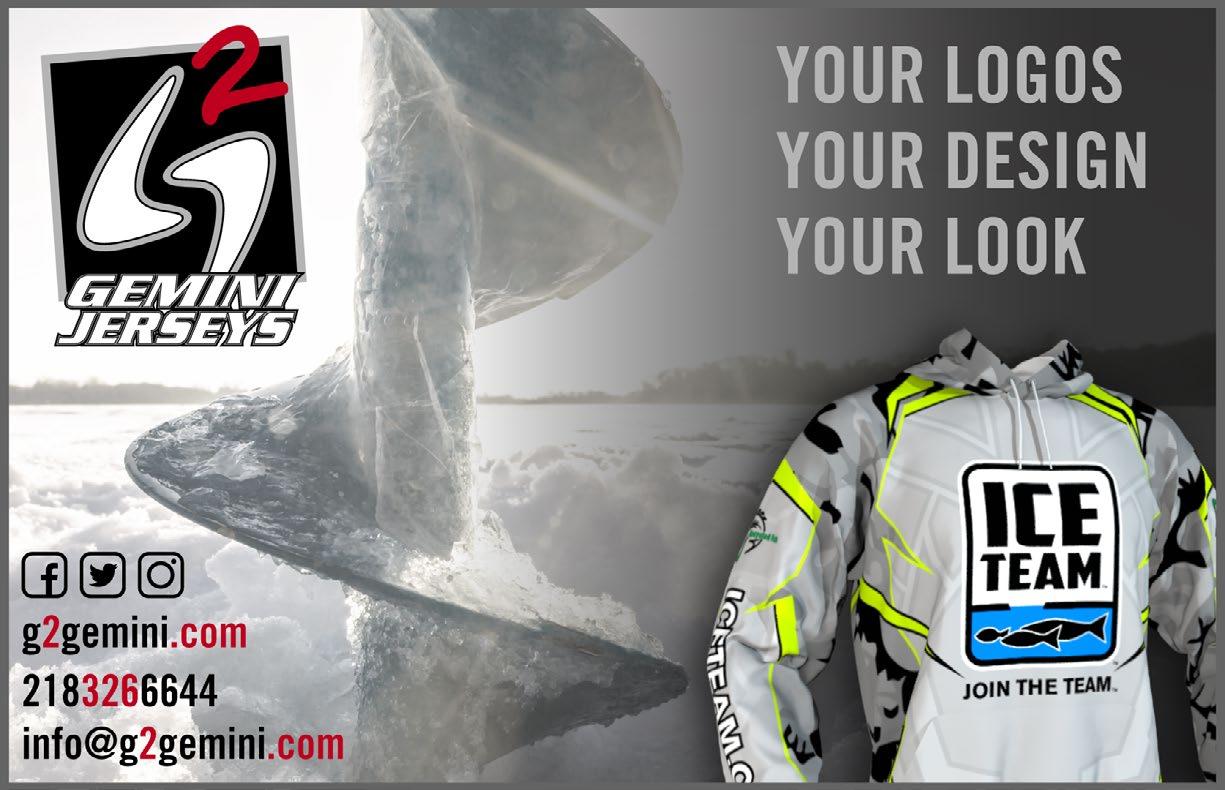

This piece of Clam Pro Tackle flies under the radar but has been a workhorse for me since the day I’ve tied it on. It has a reputation as a perch killer but it is so much more than that. Effective from deep to shallow and for so many species.
I spend most of my time on fisheries that have a wide variety of species. You really never know what might swim in from Lake Michigan. I know that if I’m perching out in the basins and get an opportunity at a cisco, walleye, trout, white perch, rock bass, catfish, big smelt, or pike that I have a chance. Not only a chance to get a bite but that as long as I take it easy, a strong enough chain and hook to successfully land that fish. Big enough to grab the attention of an incidental predator fish and finesse enough to snatch finicky panfish. We’ve caught them all on that bait!
It can be just as effective in shallow weedier waters on gills and crappies. I’ve seen it make a huge difference in highly pressured areas where everyone
has a small tungsten jig down. It goes against the grain of downsizing during a tough bite but it is a different look that often shallow panfish don’t see.
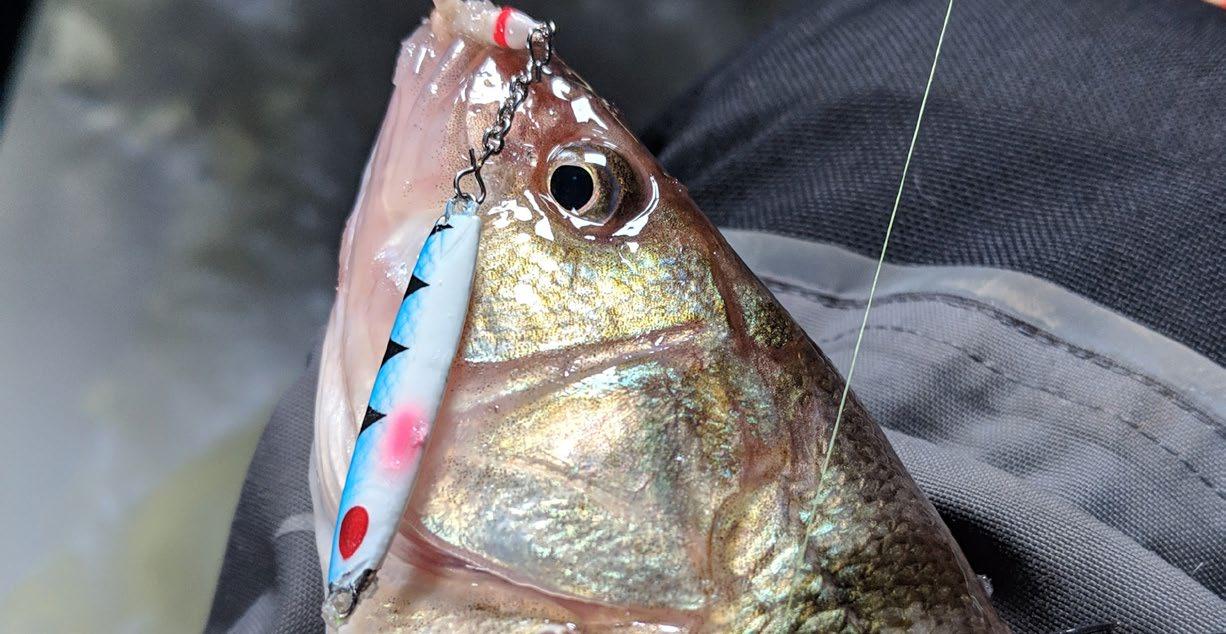
But why is it so good at times? Drawing power with a subtle presentation is the simple answer. I’m almost always dropping bright colors because I want it to be seen from a distance. I want fish to come in and investigate. But once I’ve got them interested finesse takes over. The slightest movement makes that chain and bead dance ever so slightly. Dancing it up and away is often the trick. Larger species usually require more aggressive movements while perch and other panfish just need just a little movement. Don’t sleep on it as a quickly deployed deadstick either. A stiff wind can move the rod and line just enough to make the chain flutter down below.
One of the Speed Spoons greatest strengths is its ability to get down fast. I’m often using this bait for perch in 40 - 55 feet of water and the quicker I can get down to an active school
the more fish I am going to catch. Bite windows can be brief sometimes lasting just minutes only after you’ve gotten one fish to feed and fire up the school. I’d rather snatch 2 or 3 at a time than be waiting for a smaller presentation to work its way down there. I can also cover water with it quickly, efficiently gridding out the deep flats looking for schools.
Call me old school but I’m still a big fan of tipping my presentations with meat these days. Not that you can’t use plastic on the speed spoon but meat really shines on it. A big glob of spikes gets the call anytime I’m searching for perch or am targeting panfish. The simple durability and less time I have to spend adding bait is a big advantage. Fresh or salted minnow heads are another popular choice for me. For a deadstick a live minnow or carefully hooked wiggler can be the difference between having a great day and struggling with a tough bite. Give it a shot your next time on the ice and Speed Spoon your way to success.
iceteam.com >> Ice Digital February 2023 Issue >> 13
STAND YOUR GROUND.





The most convenient way to ensure your tailbone won’t meet that hellaciously hard ice, just strap the Apex Ice Cleat on, grab your auger and start punching holes knowing there’s no ice condition these babies can’t sink their teeth into.















20 MULTI-DIRECTIONAL, SAW-TOOTH STAINLESS CLEATS FOR THE ULTIMATE TRACTION AND QUICK MOBILITY.




APEX AVAILABLE AT SHEEL’S,
OTHER FINE OUTFITTERS.
CABELA’S AND











Connect with us @scheelsoutdoors SEE WHAT’S BELOW SHOP HERE ICE FISHING FINDERS

Iknow that we are all itching to get some safe ice here in Illinois as our neighbors to the north have already been out on the ice for the past month. Our time will come and when it does, I am sure that most of us will be ready to hit our favorite lakes and/or ponds.
When hitting the ice we have been given so many different options in jig types that it can easily make your head spin. We have lead, tungsten, horizontal, vertical, swimming, pounding, and the list goes on and on. However, there is one item that many fishermen take for granted and that is the type of bait that they choose to add to their jigs.
Some purist anglers have made the choice and often express their strong opinion on the use of live bait on their offerings. Be it wax worms, spikes, or eurolarve they all are options that the angler has while chasing fish through the ice.
Live bait is an excellent way to offer up an easy meal to your quarry, however many people often overlook the use of specialized plastics that can often out produce live bait under many situations.
Some days it doesn’t seem to matter what type of live bait you tip your jig with you just can’t seem to entice those bigger fish to take your offering. In my opinion it is days like these that it is time to switch things up a little and pull out the plastic. Hand poured plastics are the way to go as they offer a more supple plastic that has much more movement in the colder water.
Plastics for the winter are just like those used by bass fisherman all around the globe as they come in multiple shapes, colors, sizes, and even flavors. However, it seems best when out on the ice
to keep it simple and work with a few shapes and colors. You don’t want to be overburdened with so much gear you just can’t seem to pull your sled.
These plastic baits have been specially designed to imitate insects that you may find under the surface of the ice. The shapes and colors are that of different larvae of these insects that the panfish are often feeding on during the winter.
I have recently listened to Mr. Scott Brauer from Maki plastics talk about how the evolution of the ice fishing plastics has developed into an entire industry of itself. This man knows more about bugs than one would ever want to know. This is what has helped him develop his products for CLAM outdoors and grow his brand under the MAKI name.
It is very interesting to hear him talk about the reason for the colors, shapes and sizes of these plastics and how they have evolved over time. It is something that you would not think was much of a science, however the way Scott has approached this it certainly is a sort-of science in the approach that is taken to develop these baits.
As mentioned, there are a multitude of shapes an colors of these plastics and it is often difficult to narrow down just which one you should put on your hook. To me I have not really gotten down to the science of the color but have developed my own technique in which I choose my baits.
I tend to choose a few colors that cover the spectrum of forage, and light conditions that I may face. Red is always a great color as it can simulate a blood worm that is often found in most lakes. White is a good choice as well and to round things off grab a black
and chartreuse. The black will give a nice profile in the low light conditions and in the brighter sunlight the chartreuse can call in fish from long distances.
The key to a good plastic is that it is soft and supple even in the cold temperatures. You want to look for something that is going to give you the most action under the frozen surface. It also doesn’t hurt to have something with a little flavor like Anise or garlic. These tend to keep the fish holding onto the bait longer and offering a better chance and a good hookset.
Most of the time I find that the use of a horizontal style jig works best; This style of jig allows the plastic to move freely and offers the best action to the plastic. The fish see the tail and the erratic movement and to them it is a struggling larvae or blood worm.
Now you might think “why not just use the same live bait that the fish would be feeding on”? That is not necessary a simple question to answer, but I can tell you from experience that there have been times on the ice when the plastics have proven to out produce live bait hands down. As mentioned earlier these plastics are developed to look like the actual insects that the fish are feeding on during these winter months. The key is to “match the hatch” as most fly fisherman would say.
Now this is not to say that I strictly am using plastics. On the contrary. I love using a big juicy wax worm or a minnow head when chasing fish through the ice, however plastics are proving to be an easier, quicker and often better producer of larger fish.
In my neck of the woods bait shops are not always easy to find and when you do find one you
iceteam.com >> Ice Digital February 2023 Issue >> 17
are at the mercy of their unusual hours of operation. This is yet another reason that I tend to lean more on plastics. They are something that I always have on me and don’t need to rely on a local bait dealer to be open.
In my opinion plastics should be in every ice fisherman’s box as they are often times a better substitute for live bait. They will bring in the larger fish and often will entice a bite out of the finickiest of fish. They also last much longer than live bait and are easier to use on those bitter cold days.
The next time you are out on the ice and the bite turns tough or you just can’t seem to get those bigger fish to go, switch up to some plastics and give them a go.














HIGH-PERFORMANCE SNOWMOBILE SKIS www.caproskis.com | 1-888-321-6789 RACING xt • Mini xt • mini MOUNTAIN/UTILITY bx • Mtx bx • mtx CROSSOVER xcs xcs TRAIL xpt • RZ xpt • RZ Maximum Floatation Utility Skis Ideal for Ice Fishing! Mtx mtx Official Skis of the CLAM ICE TEAM iceteam.com

Ice fishing offers multiple new experiences over traditional open water fishing. The ability to sit in a heated shelter is one advantage, as is staying precisely in one spot when over a weed line or brush pile. The relatively low cost of the equipment and quick access to your local water are other reasons to enjoy the sport. But, for me, nothing can match sight fishing through the ice.
Few other experiences top the close-range interaction with nature as a bluegill swimming up to a bait, mouthing it, spitting it, and eventually eating it—all two feet below my feet. The hookset and satisfying fight is icing on the cake. Sure a standard sonar can represent this encounter via pixels, and topwater fishermen see a strike during the summer, but the multiple feeding methods of different species in winter has no comparison.
My favorite species to sight fish is the bluegill in shallow weedy bays. Occasionally, a late season crappie, or even a small pike will move in. To find the green weedlines active with fish look towards northern bays with shallow water. Drive these bays in the fall to check weedline locations and depth. If fish are here in November they will still be feeding at ice up in December. While some areas remain productive throughout the season, by late ice the warming creeks will again bring the weedline to life with fresh water, high oxygen content, and green weeds.
With my Lowrance Active Target forward facing sonar I can find the weeds easily.
An underwater camera greatly assists in understanding the weed line and if you have green weeds. Even a black-and-white camera will indicate if the weeds are sturdy and alive instead of wilted and brown. The camera
makes finding the exact weedline easy and occasionally even shows some fish in the immediate area. All of these clues greatly increase an angler’s confidence in the spot.
Sight fishing can be done with and without a shelter. The Clam Scout XL Shelter is easy to position and move throughout the day. Or a Stealth Spearfish Thermal Hub house will work great being it is all Black on the inside and roomy enough to take the kids fishing with you. Without a shelter, key hints like standing with your back to the sun (to hide the hole) and keeping your line to the side of the hole (so the hole edge breaks up your profile) reduces the chance of the fish spotting you before attacking the lure.
Rarely do winter bluegills attack the lure without watching it first. The fish swim in slowly then sit and move their fins while studying the bait. The temptation to stop jigging must be controlled because the fish liked something they saw. If I keep moving I have a chance, if I freeze my hookup rate drops as usually the jig starts to spin.
The next event is what defines bluegills for me: The sniffing and pecking at the lure before the actual take. Those tiny mouths expertly suction prey into the mouth, taste it, and reject it. This may happen three or four times in a row. On sonar, this turns into a guessing game as the fish may grab the non-hook end of the lure and many hooksets end without success. Visually, I can see the lure disappear knowing that a hookset will be successful.
Just as vital is knowing when a fish turns away from a presentation. A hop or jig with slightly too much energy that turns the fish away gives a hint to tone down the delivery. A
fish that watches for agonizingly long minutes might finally respond to a specific action that, when repeated, seems to be magic the rest of the day.
My rod of choice is the 28” Katana Ultra-Light using the Gravity strait line reel it helps reduce line twist. Three-pound Frost Ice Premium Monofilament Metered line in orange helps identify bites when not sight fishing and is light enough to generate the delicate jig motions needed for finicky panfish. A #10 Clam Pro Tackle Dropkick jig with live bait or a white Maki Jamei works wonders in most situations. I also use the 1/32 oz Pinhead Pro in Gold Black Halo with 2 colored euro larvae on each hook.
When fishing a new area, I always drop a camera to view the weeds and visualize my presentation. Using the camera in down-view mode helps dial in your jigging presentation.
When that first fish comes along I can identify the species, monitor my presentation, and evaluate the response of that fish. Even if I miss that fish I have learned key information that can be applied the rest of the day. After a few encounters I may pull the camera and work exclusively with a sonar, but those images from the initial drops fuel my knowledge for the rest of the session.
Take advantage of the unique aspects of ice fishing and watch the bite. If the fish are there, I see them, If the fish are finicky, I figure them out. All this happens within inches of my feet under the ice.
Captain Scott Seibert
iceteam.com >> Ice Digital February 2023 Issue >> 21
In the pantheon of destination fisheries, Lake Cascade, Idaho has recently risen to national prominence as a trophy perch lake nearly unrivaled in the production of monster yellow perch. Ice Team Pro Don Cox has a renowned history of success on the lake, serving as guide and mentor to numerous anglers looking to stick a jumbo perch. For the past several years, Don has been part of a group of anglers that made the trek westward to target these legendary Cascade perch through the ice.

This year, Don was accompanied by a couple Lake Cascade firsttimers seeking to utilize his experience to help them maximize their chances of snagging a giant. While most newcomers to Lake Cascade quickly get overwhelmed by the sheer size and variety of structure present in the lake, Don took some time to outline several of the factors that will quickly help to eliminate unproductive fishing and help to maximize the chances of icing a Lake Cascade giant. According to Don, proper gear, the selection of electronics, and understanding the fishery all contribute to success.
Before you even depart for the lake, choosing some tried-and-true baits will coax those fish into biting. The CLAM Pro Tackle Tikka Minnow’s ripping and gliding action draw big perch in, and trigger the bite. Another go-to lure, the CLAM Pro Tackle Leech Flutter Spoon, tipped with some live bait, features both the flash and the flutter that perch crave. Finally, the CLAM Pro Tackle Pinhead Mino allows for a quick drop to active fish, and an enticing wobble if they get tight-lipped. Having a variety of colors and sizes at the ready will increase your ability to respond to how the fish react throughout the day.
The next factor for success is simply navigating the lake effectively in order to maximize fishing time. At over 20 miles long, and almost five miles wide at the widest point, Cascade is a significant body of water to cover with a variety of contours and structure. In addition, Lake Cascade experiences dense fog, and at times, heavy snow, that can shroud the entire lake in a trackless haze. One minute, the view is pristine and clear, and the next, fog rolls in and travel without GPS becomes challenging, and even dangerous. Using a GPS phone app, like Navionics, or a stand-alone GPS unit will ensure safe navigation through any conditions. Marking your lake
access point, slush pockets, and fishing hot spots will certainly help keep everyone safe and productive through the Cascade trip.

Probably the most critical factor to success is the ability to identify and interpret information from your Vexilar. Because Lake Cascade is chock full of several year classes of yellow perch, marking fish with the Vexilar is not a challenging task. More than likely, from five feet of water out until the lake’s deepest point, the screen will light up with perch flitting around. Correctly interpreting the marks on the screen will help sort out time spent fishing and targeting trophy-size fish. Small perch will often appear as a single, large mark, only to break apart as they approach the lure. Fishing areas with high populations of smaller perch requires fishing through the swarm, and paying close attention to when larger fish shoulder their way through the herd to strike. Newcomers to the lake will often spend too much time working schools of smaller perch, and getting frustrated with a lack of results. Sometimes areas with fewer small perch will feature cruising giants that flash onto the screen and react to more aggressive jigging techniques.
As a CLAM Pro Staffer, and selfproclaimed ice fishing fanatic, Don puts in the time on the ice to push the boundaries of the best fishing gear on the planet. Each of these tips will help you maximize your time and effectiveness on the ice, and ensure the highest possible chance to strike Lake Cascade gold. Slab perch are in abundance, and this fishery features the best opportunity to put a true trophysize perch on the ice. And if you see Don on the ice, stop by and thank him for your trophy catch.
iceteam.com >> Ice Digital February 2023 Issue >> 23

• Best performance & features • Best sunlight-readable display • Best reliability • Best resale value • Best customer service • Best reputation Vexilar, Inc. 6667 West Old Shakopee Road, Suite 101 Minneapolis, MN 55438 952-884-5291 • www.vexilar.com A Tradition Built To Last. Vexilar.com
















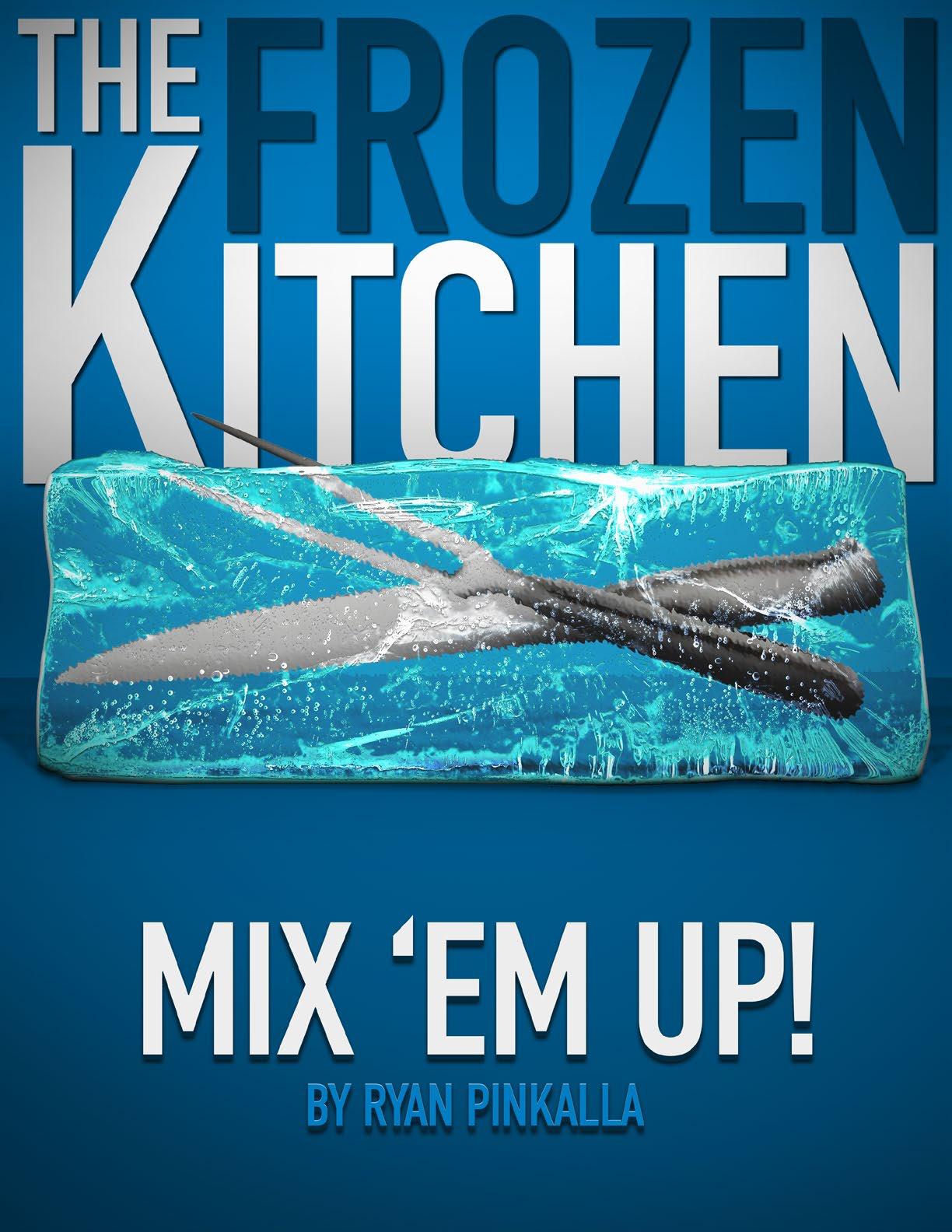
The midwinter doldrums can be a tough time to land on a hot bite. A mixture of tip-ups and jigging rods may be needed to keep the action going. At this point, evidence of successful trips is scattered around the freezer like a chronologically curated ziplock museum.
Not every day on the ice ends with a nice take of your favorite fish.
Sometimes a mixed bag of various species, of all different shapes sizes ends up making it to the fillet table. With many textures and thicknesses of meat that may be kicking around the freezer, it can be a challenge coming up with ideas to maximize the fish you have on hand. Instead of letting those bags of fish turn into unidentifiable snow-covered popsicles, make them the star of the party!
This recipe for fish fritters will change all of that. Use any combination of fish you’ve got, this recipe is simple delicious and guaranteed to be the top dog of the snack table.

FISH FRITTERS
METHOD:
INGREDIENTS:
1 1/2 lbs boneless fish fillets
• 1 egg (beaten)
• 1/3 cup mayonnaise
• 1 cup panko breadcrumbs
• 1 jalapeño, seeds removed
• 1/4 cup cilantro, chopped
• 2 shallots
Place half fish in a food processor, pulse to make a paste. Chop the remaining fish into 1/4 inch pieces. Combine and transfer to a large bowl.
Finely chop jalapeño, cilantro, shallots, green onion, and garlic. Combine with fish.
Mix in mayonnaise, egg, chili powder, lime juice and panko breadcrumbs. Season with salt pepper. Chill 10-15 mins.
2 green onions
• 2 cloves of garlic
• 2 tsp chili powder
• Juice from 1/2 a lime
• Salt & Pepper
• 2 Tbs olive oil
Form small patties, each 1/2” thick
Heat olive oil over medium high heat in a large skillet. Cook the patties until nicely browned on both sides, about 3-4 minutes per side. Serve with your favorite dipping sauce.
1.
2.
3.
4.
5.
iceteam.com >> Ice Digital February 2023 Issue >> 27










Connect with us @scheelsoutdoors GEAR UP WITH w Connect with us @scheelsoutdoors PORTABLE + WARM






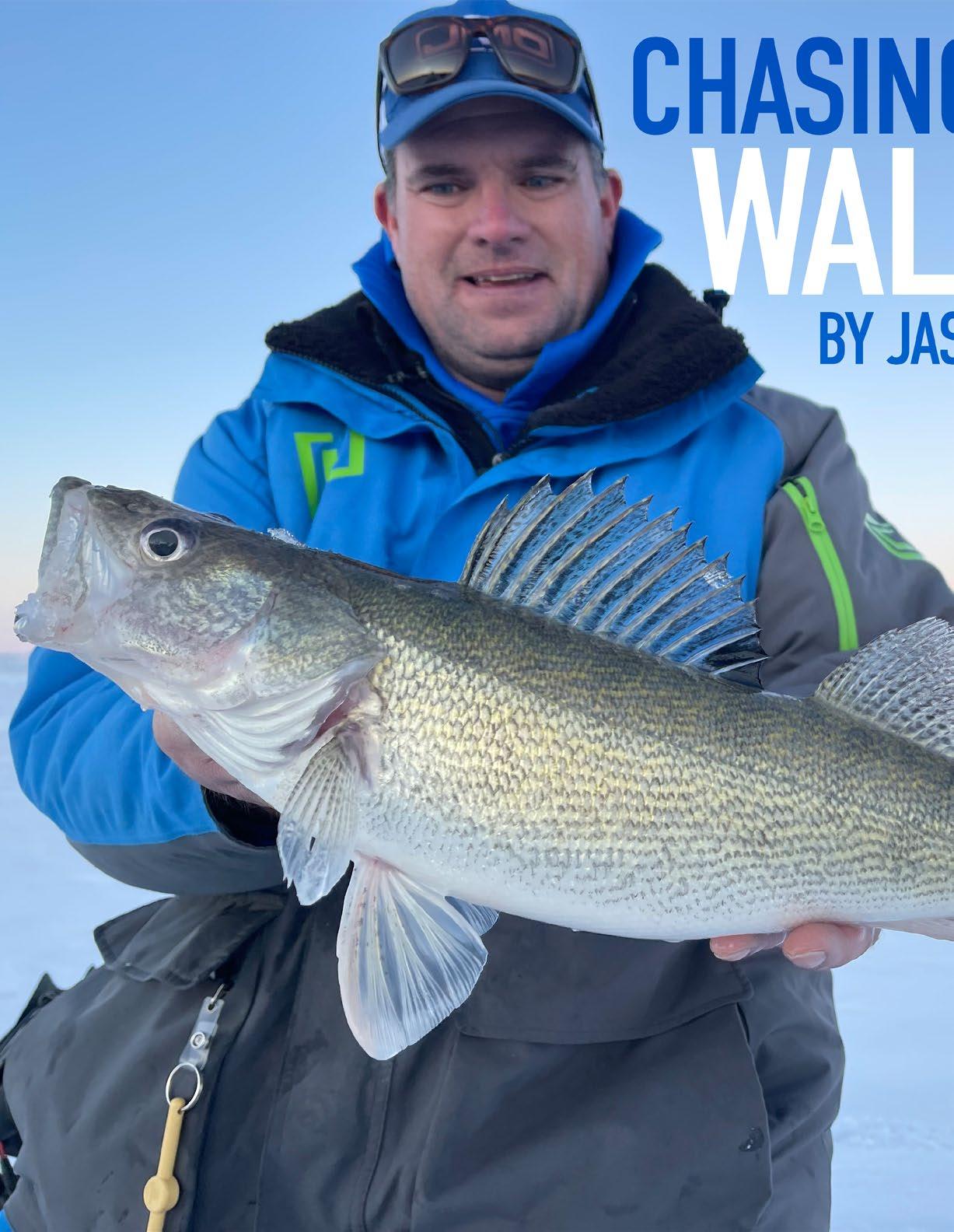
30 >> iceteam.com >> Ice Digital February 2023 Issue
There are many truths regarding fishing that are hammered into our heads. Much of this age-old wisdom is right much of the time but a problem arises when this wisdom is wrong for a specific day or application. There are no absolutes with fishing. Case in point… How often have we read or heard that walleyes have eyes on the top of their head and we should always fish above the fish? Most of the time, you can’t go wrong erroring on the side of fishing above the fish. Fish can see the presentation from much further away and if you can get a fish to commit by rising in the water column, that fish will often eat. When we are working walleye with our electronics, the tried and true move is to slowly rise the fish in the water column by working up.
There are days however especially mid to late winter when working down is the absolute trigger the fish want. If you are marking walleye and you are pulling your hair out trying to figure out what the fish want, a game changing adjustment is working down instead of up. Why is that? I can only speculate but there are many situations where walleye are tuned into using the bottom to trap prey and in some cases,


` Requires ½" drill chuck (see web site for recommended drills)
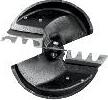
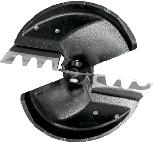
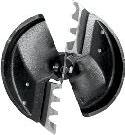
` Foam float prevents the drill from sinking
` Thermal wrap on light weight aluminum shaft
` Durable composite flighting

` Drill through 36" of ice without extension (12" and 18" extensions available)



`
for safer drilling of old holes
Watch the K-drill in action at kdrillauger.com Made By AWC 6667 West Old Shakopee Rd, Suite 102 Bloomington, MN 55438 952-224-3649 Patented Technology #7,946,355 & #10,544,626 Order direct on-line now or get one at your favorite tackle shop kdrillauger.com Official Member K-Drill is Made in the USA
`
center
` FREE blade sharpening for the life of the product (see web site for details) 6" 7.5" 8.5"
Large
point
fish are tuned into finding the prey in or next to the bottom. Blood worms, larvae and leopard frogs all basically live in the mud yet walleye have no issues finding this prey even though their eyes are on top of their head. Walleyes also get accustomed to using the bottom to pin prey.
As a result, there are days when dropping into the bottom is a very powerful trigger that seems to flip a switch. There are days when walleyes seemingly want to tip down and suck food out of the bottom. Consider this, how often during the open water season is your jig cadence essentially finding bottom and lifting to find bottom again in some fashion? How often is the strike distinguished when you find bottom and lift up to
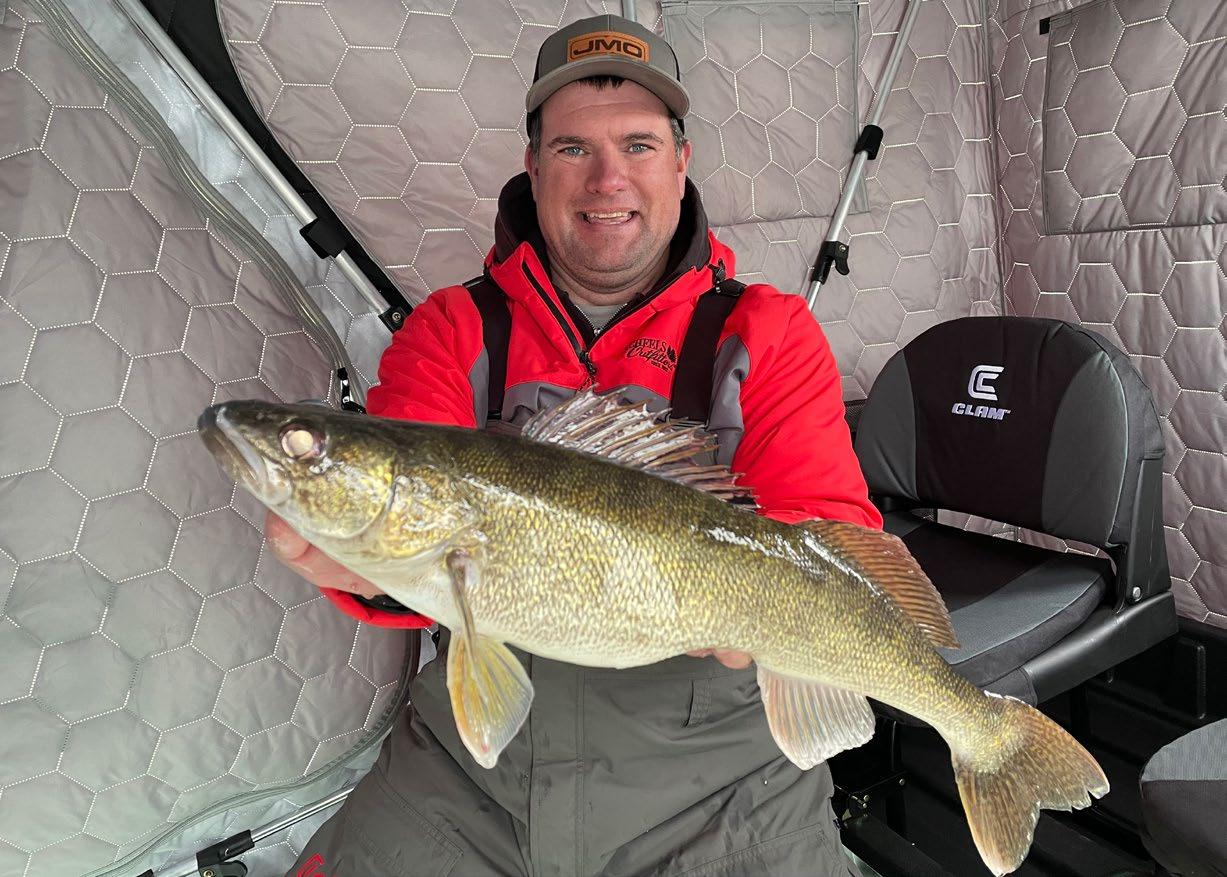
feel a fish? Same thing occurs when using glide baits like Tikka Minos or Jigging Raps… you let the glide bait barrel into the bottom and when you snap the rod tip again, the fish is just on. These fish are triggered by the bait crashing into the bottom. The fish than pin the bait into the bottom. This is one of the most powerful overall triggers we have during the open water season and is unfortunately left out of the ice angling playbook by many anglers.
There is a time and place to fish in the bottom. There is also a time and place to jig into the bottom and there is a difference between the two strategies. I find that fishing in the bottom where you keep your jig stroke within six inches of the bottom and
pound the bottom works really well over soft bottoms where fish are keying on some type of invertebrate or hibernating frogs. When walleye are spending a lot of time in the mud, you will often notice that the bottoms of the gill plate and lower jaw get a rosy pink color. These are situations where jigging in the bottom can shine. These fish are orientated and looking to eat stuff they find in the mud.
Jigging into the bottom more resembles the cadences we might use with jigs and glide baits during the open water period. We might lift the lure a few feet or more up off the bottom and chase the lure with the rod tip on slack line into the bottom. You still get the advantage of getting the lure up
32 >> iceteam.com >> Ice Digital February 2023 Issue





Know Before You Go Call 612-229-3941 or visit www.winrectech.com for more information. ICESPY™ is the remote ice thickness monitor that lets you fish your favorite spot sooner, longer, smarter. Say Hi to ICESPY™ © 2022 Winter Recreation Technologies LLC. ICESPY™ by Winter Recreation Technologies LLC. Patent Pending. All rights reserved. No ice is ever completely safe. This device is meant to provide information as to the possible thickness of the ice that exists only where the unit is located. Winter Recreation Technologies LLC makes no warranties, express or implied, as to the ability of this product to determine whether any ice surface is safe to be entered upon by the user. Any act or failure to act based on a reading from this product shall be at the user’s own risk. w Connect with us @scheelsoutdoors gear up for the season SHOP HERE ICE FISHING GEAR THERE IS A TIME AND PLACE TO FISH IN THE BOTTOM. THERE IS ALSO A TIME AND PLACE TO JIG INTO THE BOTTOM AND THERE IS A DIFFERENCE BETWEEN THE TWO STRATEGIES.
off the bottom where fish can see the lure from greater distances but the trigger is going down instead of up. These fish will chase the lure and the trigger is when the lure hits the bottom. When you can let the lure hit the bottom hard, there is also a visual and noise trigger. This basic move is perhaps the most overall overlooked move for triggering winter walleye. When you lift up, the fish is just on. With both fishing styles, the actual bites are often distinguished when you lift up. The bite will feel different compared to when you are lifting the lure up in the water column.
The truth is… walleye have a range of vision that is much broader than what we might imagine. For example, just from watching walleye in spear holes… fish don’t have very good vision if you are directly above the fish and not out in front of the fish. Walleye also seem to struggle to see you















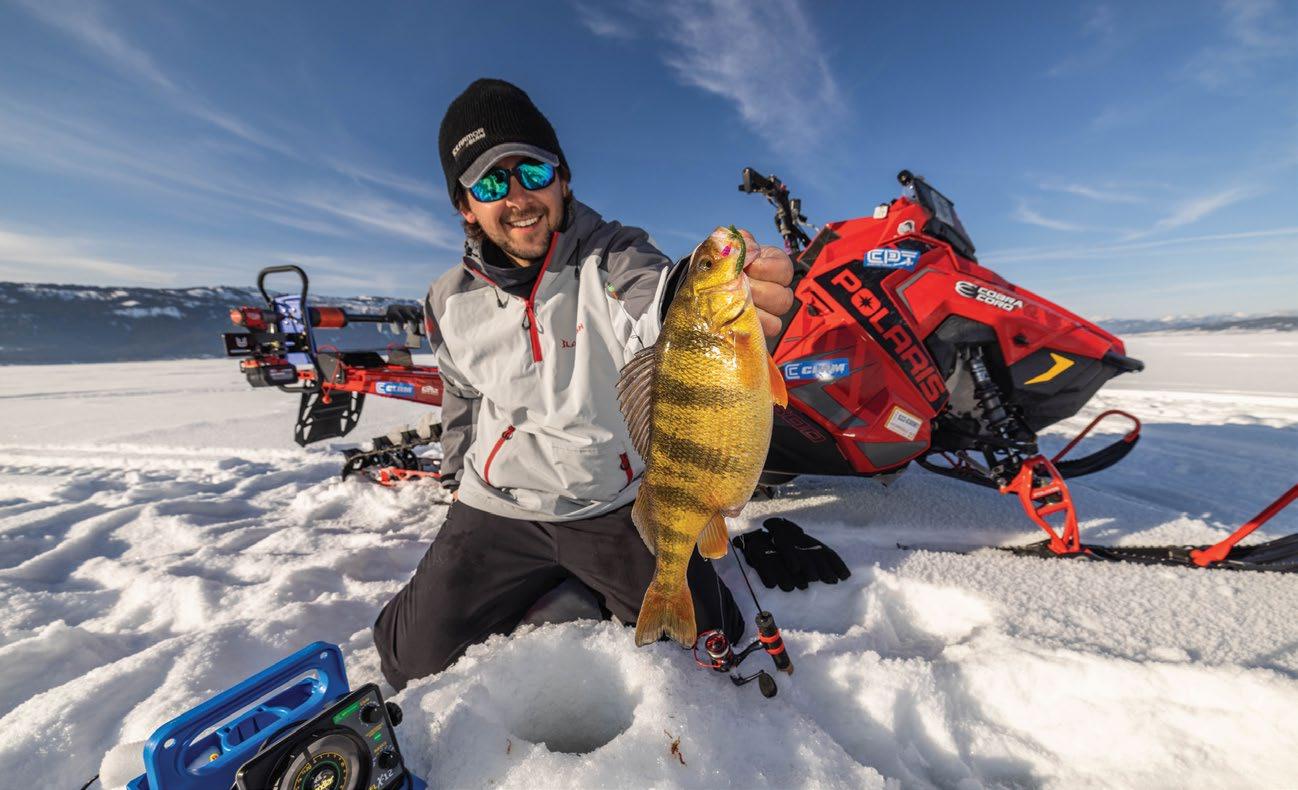
if you get behind them. You can actually watch them back up, tilt up or tilt down to keep the lure in their line of sight. Fish also use their lateral line much more acutely than what many anglers would imagine. There have been so many times for example where I have watched walleye accelerate and miss a lure where the lure was behind the fish and the fish could no longer see the lure. By pounding or shaking the lure hard, you could turn the fish around… that is because of the lateral line. A walleye can pinpoint a lure with the lateral line like a turkey can pinpoint sound if you displace water or have some type of sound component.
This fishing down strategy simply compliments fishing up. Many days, fishing in a way to bring fish into your electronics and slowing down the cadence when fish close the distance is the move and the move is fishing up. A game






of cat and mouse where you attempt to figure out what the fish want, perhaps a keep away short hop and quiver or a steady slow raise with a quiver. What I have found however is that many tough bites can be turned on like a light switch if you are willing to go the other direction with your presentation. See what happens when you start working down and don’t be afraid to work down aggressively. Let the lure free fall a few feet into the bottom and let it lay in the bottom momentarily before ripping the lure up again and free falling again. Try hitting the bottom with short fast taps and keeping the jig right in the bottom. I am confident that if you add these additional presentation arrows into your angling quiver, you will have more options to shoot at the fish and some of these options are the very best options when more conventional jigging cadences are falling short.

THE HARDWATER BRONZE LENS
Keep your eyes covered in the brightest conditions on the ice or in the snow with polarized lenses that still let you see your screens and devices.


Enhance your outdoor experience.
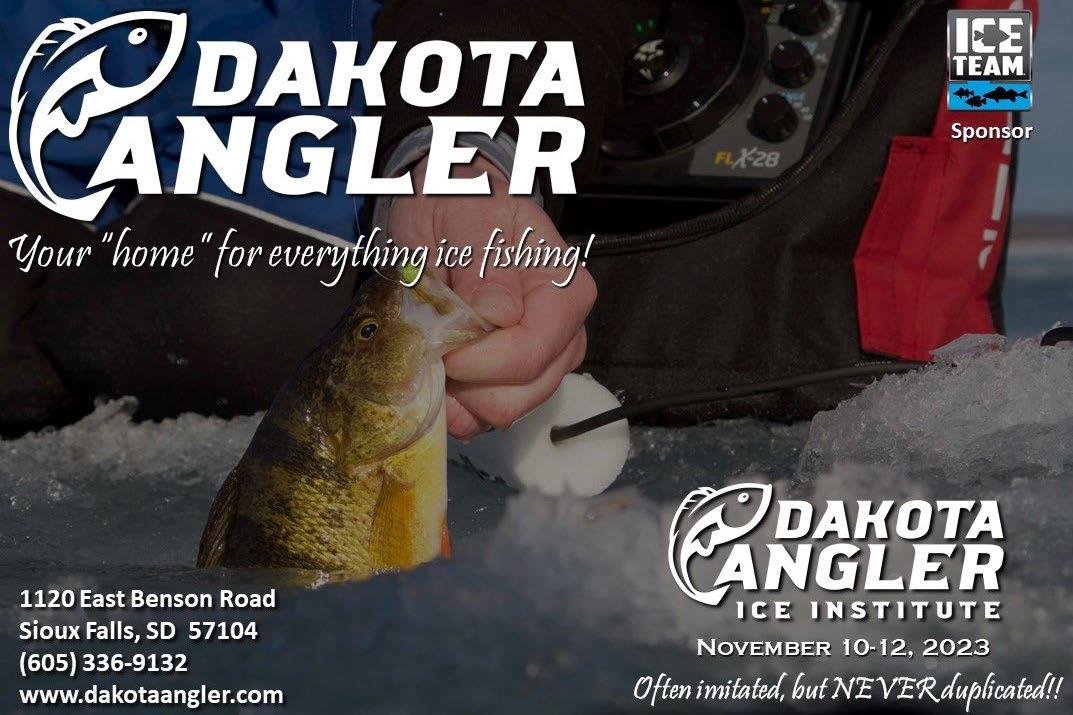
rlvnt.life/hardwater



NEW ICE FISHING TECHNOLOGY FROM RLVNT
Ice Team Member - Adam Griffith
It was shortly after noon when I finally got around to packing up the truck. It had been a busy morning at our house and my plans for a trip to the ice had been somewhat delayed. At one point, I had considered giving up on my plans for an outing, but then, the best time to go fishing is whenever you can.
It was nearly 1:00 pm when I finally arrived at the public landing of this relatively small lake. Although there were a few locals working sunfish in the shallower water, no one was in the deep basin looking for crappies.
Part of the reason for this was due to the very deep snow, slush pockets and relatively thin ice. The overall travel situation was poor.
It was a 20-minute hike to get to the deep basin area I wanted to check. Fortunately, there was a snowmobile track that I could follow for much of the way. Still, I was hot and sweaty when I began the search for crappies.
I knew exactly where these crappies should be as they tend to set up shop in the same location each winter. It did take some drilling, but I soon located a small group of fish.
After plucking a couple of ten-inchers out of this group, they moved as did I. This cat and mouse game went on for some time before I located the main school. Once that happened, I quickly finished off my limit and began the long trek back to the landing.
Midday panfish angling is something I have participated in and promoted for years. I have been very successful with this strategy and have convinced many other anglers that you don’t always have to get up early or stay out late to be successful.
My midday preference is almost always to work a deep basin. On many lakes, panfish, especially crappies,

36 >> iceteam.com >> Ice Digital February 2023 Issue
head to deep water for their winter home.
Because of the 25 to 40-foot depths I target, lowlight conditions are naturally occurring. I believe this is part of the reason midday activity takes place.
I am a very big believer in utilizing glow jigs in this deep environment. Although fish have excellent lowlight vision capabilities, a glow jig seems to get their attention better than a standard jig. Red glow is my favorite.
Because the food source for these deep fish is mostly invertebrates, I always use plastic on my jig. The plastic helps mimic the invertebrate look as well as add action when I am jigging. I find the suppleness of Maki plastics is hard to beat. I usually tip my jig with one Euro larva for a little extra scent.
These daytime fish are often on the move. Trying to keep up with these roaming crappies can be a challenge from time to time. It is just part of the process and you have to be willing to drill holes to chase them down.
I do need to point out that this midday panfish system is not perfect and works better on some lakes than others. I have been on lakes where the morning bite died once the sun was up. I have also seen situations where you couldn’t get a fish to bite until the setting sun hit the tree line.
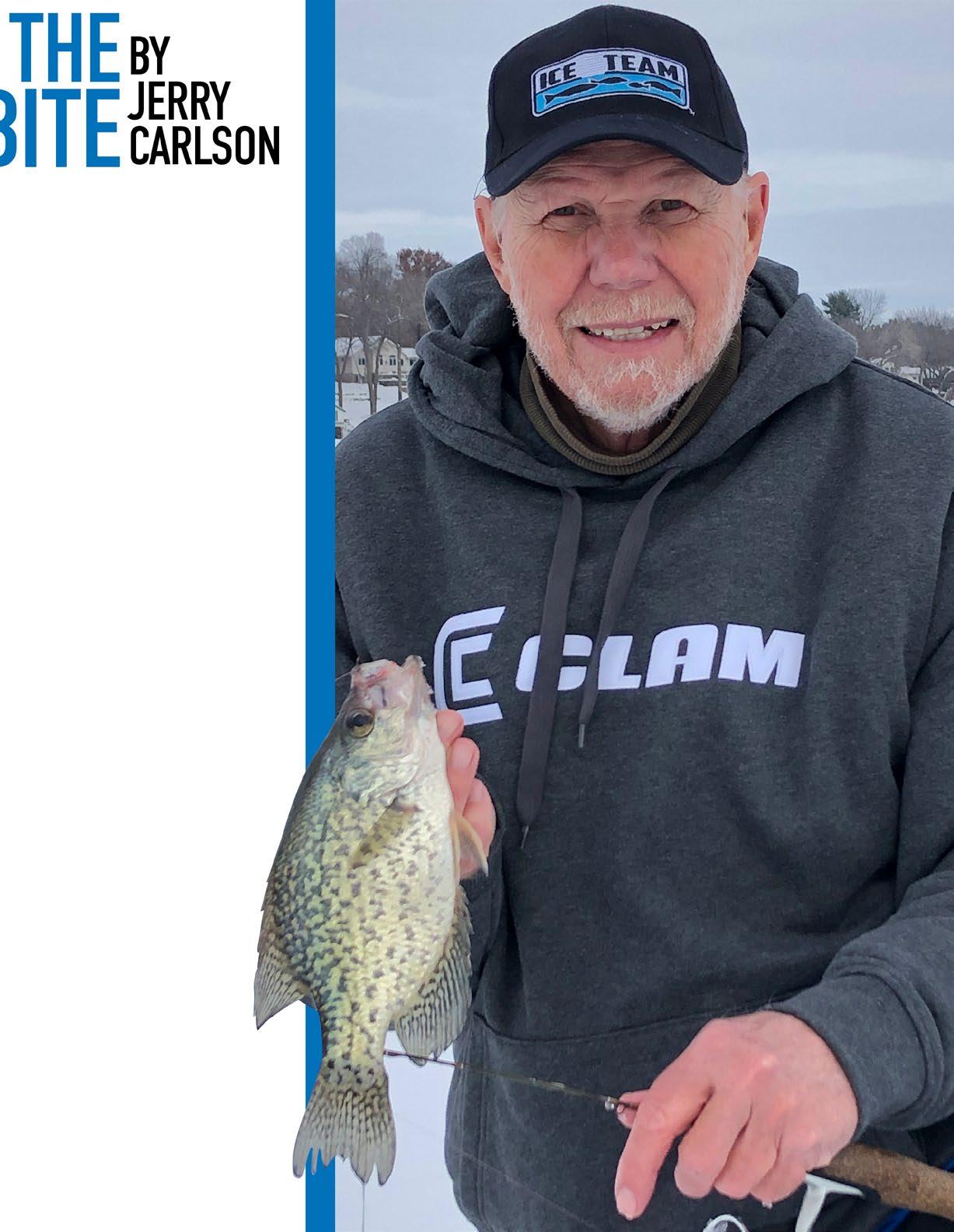
Finding a lake that has midday activity is not that hard. It just takes a little looking. I have been making it work for me for 30 years.
If you are a little lazy like me and don’t like to get up super early or stay out really late, the midday bite scenario may fit you perfectly.

Racing around on his snowmobile the Fish Hound was shuttling from hold the hole. Normally a pleasant fellow “ Captain James Vladyka” did not look happy. he was plowing through more than a foot of compacted powder and new heavy snow had already started to fall. “We’re having a midwinter crisis,” he said as he rode up to my one-man shelter, they were tight in here earlier this week but with all the snow they’ve scattered out. As he started into the squall, I’ll find them I know where else to look.
Human Fish Finder
Vladyka disappeared for a time and then returned around 30 minutes later with a pair of jumbo perch the fish were long and round bellied and as bright as autumn leaves at his suggestion I packed up my jigging stick hopped on the back of the snowmobile. And rode off into the snow for about 5:00 yd there’s something else I want you to try Veronica said when we drilled fresh holes near where he had caught his caught his Perch. He reached into his voluminous pocket took out a plastic Puck of wiggling spikes and impaled 3, one on each one of the treble hooks of his wonder bread colored ribbon flutter spoon a fresh new bait from the CPT (Clam Pro Tackle) line up. The effect was a Trident of waving white bait. when things get tough in the Winter this is one of my tricks, he said the bait is going to flutter when you work it. I’ve seen it on the camera they move just like a soft plastic something that Vladyka is very well known for using. I dropped the spoon and buggy trio into a hole and raised it about a foot above the bottom
and let it flutter its way back to bottom a minute or 2 later the stick bowed and I raised a big bodied perch another couple of minutes in a hole a few feet away a second jumble flopped on the ice returning to the 1st hole I nabbed a 3rd, Captain Vladyka was doing the same. Off in the distance I noticed a few other ice anglers were looking as disheartened as I had been but vladyka had moved me to slightly deeper water and the addition of the 3 spikes made the winter day brighter.
Mix it Up.
Most anglers know that fishing gets tougher as midwinter sets in even vladyka admits that it takes a certain stick-with-itness to catch fish during the tough season. but it also takes adjustments pounding the same hole over and over isn’t going to increase your success in many cases you need to change the depth to find fish. it could be as little as a foot or two but in tough conditions it’s even more important that you go to the fish because they are not likely going to come to you vladyka said.
The depth change and bait trio worked that day but the Fish Hound from Benson, Vermont has a larger bag of tricks he uses to solve ice fishing’s toughest time of the year. in midwinter anglers often
encounter thick milk colored ice, layers and layers of snow quickly decaying weeds and the circle of life that somewhere between hibernation and the dream state. In this environment gamefish are certainly hard to stimulate but Vladyka heads out day after day in the midwinter guiding because all though the bite can be tough he often catches the biggest panfish of the ice season in this period the panfish that he specializes in perch, crappies, and blue gills are robust and surprisingly well fed he knows where the bigger fish hang out and he has learned how to catch them.
An Underwater Eye
One of vladyka’s best gambits includes a tool that anglers can use year-round a Vexilar flasher. I don’t like fishing without my “Vexy” Vladyka said but during midwinter it’s imperative. Sonar gives him the ability to find fish and to a large extent that’s why he uses a flasher, but the fish hound said the real value is because of the need to anticipate bites. panfish will come along see your bait and take a nap he said a lot of these strikes are more curiosity than hunger so all you get is one brief bite or two, if you miss the strike the fish is gone. But he explained with a flasher that angler doesn’t have to be blindsided. I see the fish move
iceteam.com >> Ice Digital February 2023 Issue >> 39
MOST ANGLERS KNOW THAT FISHING GETS TOUGHER AS MIDWINTER SETS IN
I DON’T LIKE FISHING WITHOUT MY “VEXY” VLADYKA SAID, BUT DURING MIDWINTER IT’S IMPERATIVE.

in he said I see the flasher lines nose up and then engulf my bait. instead of being caught off guard and not reacting quick enough, I can set the hook just as I see the strike on the screen Vladyka had used sonar when he caught his pair of perch, and it certainly was how I caught my 3. if I hadn’t been using it the soft nips and the blowing snow might have felt like nothing more than a shiver in my hand the perch would have drifted away without another hit. Its more curiosity than hunger at this time and the only way fish can satisfy their curiosity is by biting the bait Vladyka said. flashers also helped you lure fish in close and tweak their curiosity this is important in the midwinter because panfish are usually not in tight schools they are often sparse and scattered when one appears on a flasher Vladyka does everything, he can do to catch it. he’ll work a hole thoroughly leaving only when he thinks the fish have moved away. that means going through a repertoire of jigging actions from stationary to slow, to moderately aggressive, moderately aggressive is how he describes the best jiggy action for tough midwinter conditions the jigging motion is twitching lift and drop the twitching more of a palsy like shaking of the rod. he accomplishes this by placing his index finger on top of the
WHEN IT COMES TO DRILLING HOLES, VLADYKA IS A REGULAR CONSTRUCTION WORKER.
blank and tapping it like a piano key as he taps, he raises the rod 1 or 2’ and then he lowers that while keeping slack out of the line and always tapping. the rod tip quivers but doesn’t whip even when he’s holding the rod stationary or during a slow lifting of the rod, he is using his index finger to Pat the blank what this does is make the string of spikes or soft plastic wave upand-down Vladyka said it’s a very enticing action. in addition to hooking multiple larvae on a single jig Vladyka also says that soft plastic is needed for the midwinter crisis. The Jamei a soft plastic bait that Vladyka helped his longtime friend Scott Brauer owner of maki plastic design is a great bait for this time of the year its long body with short Celia hairs coming out each side and a twin tail design giving it a grass shrimp imitation. that and its tremendous action seem to be a combo the fish can’t refuse. It has become a go to for a lot of anglers across the ice belt myself included.
No Shoveling Zone
The problem of snow around and ice divot often comes under consideration during midwinter conditions many anglers will clear snow away from a hole simply because it’s easier to work but Vladyka only removes the snow that his auger whisked away when drilling I think the fish get spooked by suddenly having the bright light
come down on them he said this doesn’t matter when it’s overcast and snowing but on a bright Sunny day I think it can be a real turn off for the fish. When it comes to drilling holes, Vladyka is a regular construction worker. he prefers to drill a lot of holes when he first arrives on the ice rather than making 1 or 2 fishing them than drilling 1 or 2 more. “The winner world is pretty quiet” Vladyka explained I think that’s why I like ice fishing so much if you are always making noise, it doesn’t seem right to the fish they tend to slink away. drilling and scooping out a dozen or so holes at a time means the fish can forget the chatter and resume their lives if while drilling if they move off and frighten the intervening times gives them the chance to return also the multitude of holes is Vladyka’s idea of covering a lot of ice for scattered fish. it’s nice if they are tight in schools but once you get thick ice and a lot of covering snow that’s not the norm he said some good cover might hold a pack of panfish but more often they spread around working a lot of holes gives you a chance to find more individual fish in addition Vladyka will spread his holes over a range of depths covering 1 to 2’ increments until you find the fish, You have to move a lot in the winter it’s the name of the game. I encourage anyone if they have never been to Vermont to make time to go if you get to fish with Vladyka that will be a bonus.
Captain James Vladyka
802 774 8042
www.fishhoundsoutdoors.com
Vic Attardo
iceteam.com >> Ice Digital February 2023 Issue >> 41

Ithink its fair to say that ice fisherman spend as much or more time modifying their equipment than any other angling group. While companies such as Clam have innovated and improved products to the point modifications aren’t as needed as they once were, its still fun to do. In some cases, regional needs can create the need for additional modifications. Here are a few that I do to help me on the rough terrain the Great Lakes is known for in the winter months.
Floor
Larger shacks like the X series have a lot of space for gear, but to fully take advantage of this space I use a simple hack. Through bolting a thin stripe of ¾’’ plywood to my shack floor keep larger items like minnow buckets, propane bottles and heaters from being turned upside down into a hot mess. This allows me to secure straps or milk crates into the wood, which allows them to be firmly secured in place without putting more holes in your shack tub itself.
Rear Hitch

A rear hitch is a great idea rather you intend to double up shacks or not. If you ice fish enough you will break something and this may just help you or a friend get their gear home. The Clam sled hitch receiver is a great option for doing this, but a quick step will make it even better. Instead of placing the outer two bolts in place to secure, place a 3/8’’ stainless eye bolt in it instead. This allows me to attach chains to another shack that may not have a hitch. An added benefit is you now have a secure place to tie it down on a trailer or way to hang it in your garage’s rafters.
Tackle Tray
If I’m being honest, I have given away a bunch of the Clam center console that come with some of
the X series packages. It’s not that I didn’t like it, it’s just that things that aren’t nailed down in my neck of the woods don’t end up being part of the operation. Call it a light bulb moment, but last year I decided to rivet the Clam center console in place. A couple simple rivets on each end and I now have a great shelf for my accessories that will be where I need it.
Rod Storage
Rod storage isn’t important until your rods are either all broke or all woven together. Personally, I use several different methods. The Clam 4 position rod holder is great for making sure extra rods aren’t laying around to get broke or tangled while fishing. I have always struggled with a good rod holder for rods I am actively fishing or using as a dead stick. The newer clam lock system is great for being able to mount bases all around your shack, hub or even your machine. This simple click in accessory system allows for additional items such as a light, phone holder, cup holder and bag to name a few.
A Better Seat
You don’t have to have grey hair to appreciate a good seat. The seats that come with the X series shacks are extremely comfortable, but adding the newer arm rests take it to a new level. Rather its taking a break from fishing or a place to rest your arms while you jig, these add ons are a serious gem. Pair that with the seat back storage for small items or things that can easily be misplaced and you have the total package on your shacks seat.
I’m a guy that likes to keep it simple, but sometimes simple things can help make your life easier and improve your efficiency at the same time.
Ross Robertson bigwaterfishing
iceteam.com >> Ice Digital February 2023 Issue >> 43
When we think of ice fishing equipment we often think of warm clothing, augers, and tackle boxes along with rods, reels, fishing line and lures. The one category of items that is often used but never overly discussed is snaps, swivels, snap swivels, leaders, and split shot, which are commonly referred to as terminal tackle. Although not commonly discussed, terminal tackle plays a huge role in our fishing success and often makes our adventures much easier.
Line twist while jigging can prove to be very frustrating. This is especially true while ice fishing as the bird’s nests and twisted line catching on your fish rod guides can be extremely difficult to deal with particularly with cold hands and

44 >> iceteam.com >> Ice Digital February 2023 Issue
windy miserable weather. In addition, twisted lines can often impair the action of your lures or cause unnecessary motion causing them to spin making it impossible to hold a lure completely still as a fish rises from the bottom to check out your suspended lure. I have watched panfish on camera spook from a lure as it spins in circles, yet once the line has untwisted and the lure hangs motionless, the fish don’t hesitate to take the motionless lure.
To alleviate line twists, many an angler, including myself have used snap swivels while icefishing. In doing so the snap swivel is tied to the end of the line using a Palomar knot and then the lure of choice is attached to the line via the snap portion of the swivel. As the lure is jigged up and down, the swivel twists and turns which prevents the line from getting all twisted up. Another benefit of snap swivels is that they make lure changes a simple task of opening the snap, removing the hook, putting a different hook on and then closing the snap.
The downside to snap swivels when fishing with jigs is that you are not able to tie a knot to keep a jig horizontal as the snap allows the jig to pivot and move and
when suspended and the jig will often pivot and end up hanging in a vertical presentation as opposed to a horizontal position.
To overcome this when fishing jigs, try using a small barrel swivel on your mainline approximately a foot above where you would tie on your jig. Doing so, helps eliminate line twist and allows you to still be able to tie on a jig. When doing so, choose the smallest size barrel swivel you can get by with. If you want to change your jig, keep cutting the old one off and then retying the new jig on. Once the line under the swivel gets to about 3 inches add on a longer fresh piece of fishing line.
When using the barrel swivels while fishing jigs, I quickly found out that the swivels never interfered with dropping the jigs down hole or on their retrieval. Through trial and error, I discovered that by positioning the swivel with about 12 inches of tag line, I never had any problems reeling it through my top line guide while fishing or while storing my fishing rods. I really like the inline swivel set up, so I set up some rods with swivels and instead of tying on jigs, I tie on a small Duo Lock Snap on the end. Doing so allows
me to make quick and easy lure changes just like when using a snap swivel. I particularly find this rigging setup effective when fishing Tikka Minos.
When jigging specifically for northern pike, I will tie on a wire leader. When doing so, I always use wire leaders that incorporate a swivel as I’m not a fan of line twist. While the leader is a little clumsier than mono or fluorocarbon line and isn’t a wise choice for fishing for panfish or walleye, it sure helps save lures from the sharp teeth of hungry pike. While pike don’t seem bothered by a wire leader, it is important to ensure your leader is straight and not twisted as a twisted leader will spoil your presentation. Therefore, if you catch a pike and the leader gets twisted or kinked, tie on a new leader.
Split shot is another form of terminal tackle that ice anglers may utilize at various points throughout the ice fishing season. Split shot is often used when suspending a small lure under a slip bobber so that the bobber is neutral buoyant. Split shot can also be used when fishing with tip ups to help a dead bait like a smelt or cisco drop quickly to the bottom. When using split shot, I often like to use painted or glow split shot for added visibility down hole. In addition, I like to string the split shot, so the lightest pieces are closest to the lure and the heavier ones are higher up the line.

iceteam.com >> Ice Digital February 2023 Issue >> 45
TERMINAL TACKLE PLAYS A HUGE ROLE IN OUR FISHING SUCCESS AND OFTEN MAKES OUR ADVENTURES MUCH EASIER



